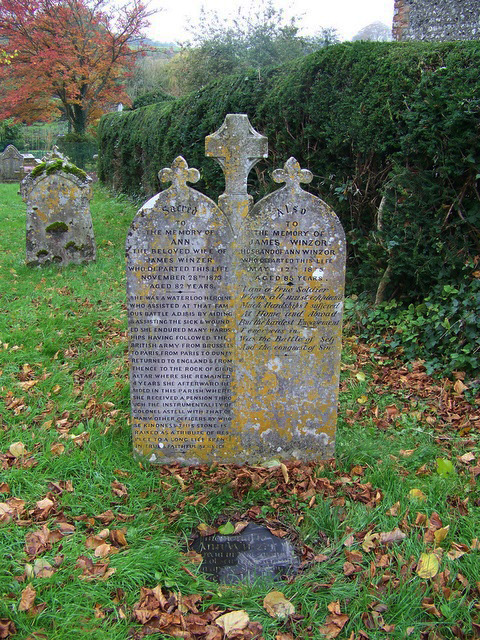
Grave of Ann Winzor in St Mary’s
Churchyard Piddlehinton
© Picture Copyright Trish Steel and licensed for reuse under this Creative Commons Licence
SACRED TO THE MEMORY OF ANN
THE BELOVED WIFE OF
JAMES WINZOR
WHO DEPARTED THIS LIFE
NOVEMBER 28th 1873
AGED 82 YEARS.
-----------
- She was a waterloo heroine who assisted at that famous battle AD.1815
by aiding & assisting the sick and wounded she endured many hardships
having followed the British army from Brussels to Paris. From Paris to
Dunney returned to England & from thence to the rock of Gibraltar
where she remained 4 years. She afterwards resided in this parish where
she received a pension through the instrumentality of Colonel Astell
with that of many other officers by whose kindness this stone is raised
as a tribute of respect to a long life spent in true and faithful service.
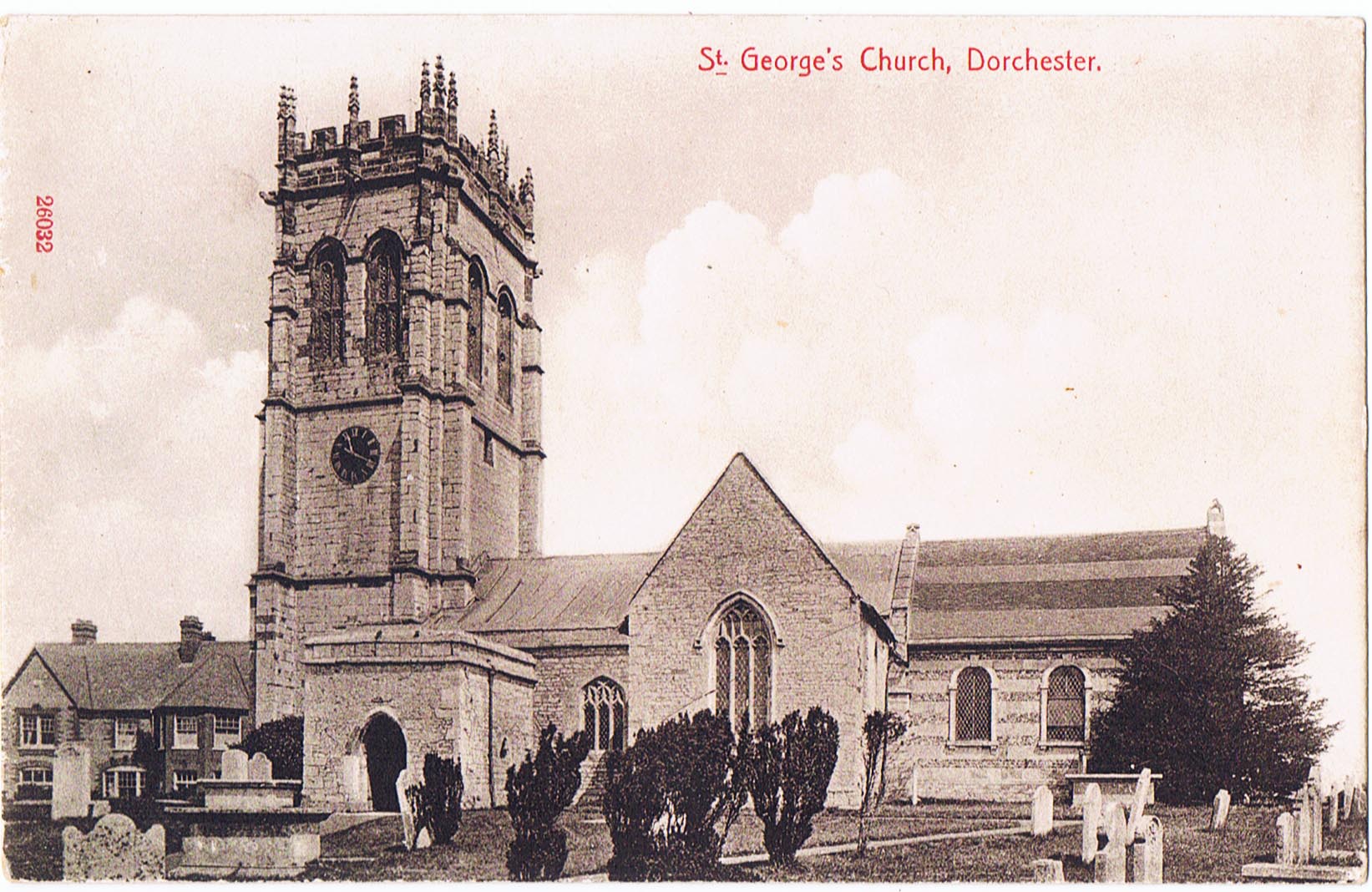
St Georges Church Fordington circa 1904
© Private postcard collection Michael Russell FIPD - Aug 2011
Ann Keats age is given on her tombstone as 82 which suggests that she may have been born as early as 1791, but census returns lead me to believe that she is much more likely to have been born in 1794. This also fits neatly with her baptism which took place in St Georges church Fordington on 28th January 1795.
The post card of the church shown above dates from 1904 and shows the church as it stood for many years prior to its redevelopment and extension at the hands of the Rev R.G. Bartelot who arrived in 1906. Her parents Joseph Keats and Elizabeth Brine had married in this church in 1776(2) and produced 2 much older siblings for her, Sally (in 1777) and James (in 1781). Her birth must have come as a bit of a surprise as more than a decade had passed since their last child had been born and it came at the end of a particularly difficult time in European history as the King of France Louis XVI had just been guillotined in Paris, and the French Revolution had entered an appalling new phase known as the 'Reign of Terror'. It was headed by Robespierre and anyone suspected of opposing the new regime was executed. In 1794 around the time of her birth, Robespierre himself was guillotined and the 'Terror' abated somewhat but there was great concern in England that a similar revolution might occur here and the barracks in the town assumed an important role at a difficult time. Dorchester was particularly well informed as many of the merchants that ran the town had interests in France and news arrived there, often before it even reached London, via the many trading ports on the coast such as Portland and Weymouth.
Ann no doubt was oblivious of these great events as she grew up within the sound of the great bells of St Georges church, but by the age of 10 she would have been aware that war had broken out with France and that Napoleon Bonaparte had crowed himself Emperor.
If, as I believe, Ann was born in 1794 she was only 17 when she married in St Georges church on 1st April 1811 to James Winzor who lived in the nearby parish of Holy Trinity in Dorchester. James was the son of Philip Winzor (3) a native of Fordington and his wife Mary Purchase from Dorchester. James was two years older than Ann, having been baptised in St George’s Church Fordington on 17th June 1792. He was the second of at least six children, and would have known Ann from early childhood. Clearly their union was blessed by both families as they would have required parental consent.
At the time of James marriage to Ann he gave his place of residence as the Parish of Holy Trinity in Dorchester, the same church where his parents married in 1784. This is one of three main churches in Dorchester High Street and they were all regularly used by soldiers at the nearby barracks in West Fordington, so its possible James had already enlisted by 1811. On the 20th December 1811, just nine months after they married, James & Ann had their first child, a son, whom they named James Winzor (junior) after his father. Just two days later he was baptised in St Peters Church in Dorchester. We know from the gravestone that James Winzor enlisted in the Army and Ann accompanied him, hence her presence at the Battle of Waterloo. What we don't know is whether their young son James went with them, but later events suggest that he may have been left with James's family in Fordington.
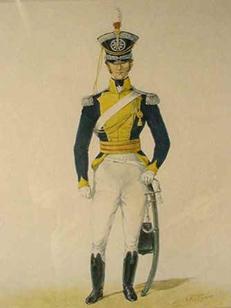 With the abdication of Napoleon in Paris on 11th April 1814 and his banishment
to Elba, James and Ann must have felt that a period of peace was stretching
before them after all the uncertainties of the previous 12 years.
With the abdication of Napoleon in Paris on 11th April 1814 and his banishment
to Elba, James and Ann must have felt that a period of peace was stretching
before them after all the uncertainties of the previous 12 years.
On the 26th February 1815 however Napoleon gave his guards the slip
and escaped to the mainland, marching towards Paris, amassing an Army
as he went. On the 13th March 1815, six days before Napoleon reached
Paris, the powers of the Congress of Vienna declared him an outlaw. Four
days later the United Kingdom, Russia, Austria and Prussia mobilised
armies to defeat him. I have not been able to ascertain what role James Winzor played at the Battle of Waterloo but we do know something of the regiments based in Fordington at the outbreak of hostilities.
<<< 12th Light Dragoons 1812
The Parish Registers for Fordington have regular entries for baptisms
for children of soldiers families from several Regiments. Detachments
of the 12th and 13th Light Dragoons were based at the Barracks in Fordington
from 1813 right up to February 1815 when there is a sudden cessation
in entries because of mobilisation. All troopers were expected to possess a long list of ‘necessaries’ not just for himself
but also for his horse.This included stockings, spare shirts, spare breeches, shoes, cleaning
equipment, horse grooming kit, firearms’ tools and any other personal items. These all
had to fit into the valise on the horse’s back to be carried on campaign. The principle weapon of the light cavalry was the 1796 pattern light cavalry sabre a weapon still prized as one of the finest slashing blades of its type ever made.
On the night of the 17th it rained continually, turning the battle ground into a quagmire. The morning of Sunday 18th was clear and found the 12th Light Dragoons of Vandeleur's Brigade on the far left of the British line. In the early afternoon Napoleon's main attack came with four massive columns belonging to D'Erlon's Division, the columns rolling forward towards the centre left of the British line. The columns began to push the line back, but were held by the charge of the Household and Union Brigades of heavy cavalry. The Household Brigade checked and withdrew after defeating two Cuirassier regiments. However, the Union Brigade did not. After smashing its way through two of D'Erlon's columns, it attacked the massed French Battery of guns opposite. Their horses blown and the men scattered, they were caught and set upon by two fresh regiments of Jaquinot's lancers. Realising the only way to extract what remained of the heavy dragoons, the 11th Light Dragoons were ordered to stay in reserve and the 12th and 16th to charge, the 12th leading. The charge Wellington later called "beautiful". The two regiments tore through the rear of the only remaining French column and fell upon the flank of the French, but were in turn charged by a regiment of lancers. This action although 'beautiful' was costly . During the attack by French lancers, Ponsonby was lost on the field. Desperately wounded having been run through at least three times by lance and sword he was left for dead. Despite being robbed and used as firing cover by a French tirailleur, Ponsonby survived until he was made more comfortable by a major of the Imperatrice Dragoons of the Imperial Guard. Having being ridden over by the advancing Prussians late in the day he was eventually found by a private in the 40th (2nd Somersetshire) who stood guard over him all night. Ponsonby survived despite his injuries which left him with a useless left arm and severe limitations of movement
Wellington lost around 15,000 dead and wounded at Waterloo, and Blücher of the Prussian Army another 7,000. Napoleon lost over 25,000 dead and injured, with 8,000 taken prisoner. It is difficult to imagine the scene of death and destruction that must have confronted Ann, but some idea may be gleaned from the following eye witness account taken 4 days after the battle:-
—Major W. E Frye After Waterloo: Reminiscences of European Travel 1815-1819
June 22 1815: This morning I went to visit the field of battle, which is a little beyond the village of Waterloo, on the plateau of Mont St Jean; but on arrival there the sight was too horrible to behold. I felt sick in the stomach and was obliged to return. The multitude of carcasses, the heaps of wounded men with mangled limbs unable to move, and perishing from not having their wounds dressed or from hunger, as the Allies were, of course, obliged to take their surgeons and wagons with them, formed a spectacle I shall never forget. The wounded, both of the Allies and the French, remain in an equally deplorable state.
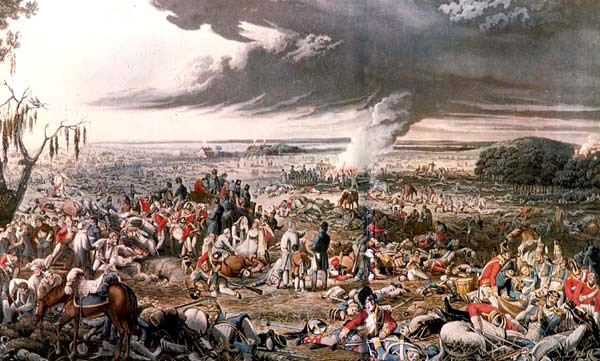
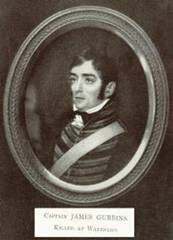 Among
the dead were 6 officers from the 12th and 13th Light
Dragoons three from each Regiment. The
picture below depicts Captain James Gubbins of the 13th Light
Dragoons who was killed at Waterloo by a cannon ball during a charge.
<<< pictured left
Among
the dead were 6 officers from the 12th and 13th Light
Dragoons three from each Regiment. The
picture below depicts Captain James Gubbins of the 13th Light
Dragoons who was killed at Waterloo by a cannon ball during a charge.
<<< pictured leftIn all the 12th had 6 officers and 106 men killed or wounded and the 13th had 10 officers and 80 men. Although these Regiments were made up of many detachments, much of the 13th for example had been mustered from Ireland, among the dead and injured must have been friends of James and Ann. After the Battle Wellington said 'Nothing except a battle lost can be half so melancholy as a battle won'.
The above account suggests that the Army had already left Waterloo by the 22nd of June 1815 and taken their surgeons with them. We know from the inscription on the gravestone that Ann tended the sick and dying at the actual Battle, but also that she went onto Paris with the her husbands Regiment, and no doubt the walking wounded. Wellington entered Paris on the 7th July and camped on the Champs Elysees. It was in Paris that Napoleon abdicated for a second time and was later sent into exile on St Helena.
Ann’s gravestone also records that she went onto a place called Duney [or Dunney] and then returned to England. As the fighting was now over this may have been to collect her son James -- if he had indeed been left behind as conjectured earlier. All we know for sure is that James Winzor (junior) died at the age of 5 and was buried at Fordington on 4th July 1817. In the space of just over a month 4 members of the Winzor family died and were buried at Fordington, apart from their young son, James her husband also lost his 20 year old younger sister. The most likely cause would have been one of the infectious deseases prevalent at that time. Ann is then said to have gone out to Gibraltar to look after wounded British Soldiers and this must have been with the blessing of the Army as she remained there for 4 years and they would have had to support her.
By 1824 James and Ann had returned to live in Dorchester and James was working locally as a stone mason having left the Army. A second son, they named Joseph Winzor, was baptised on 25th August 1824 by the Reverend John Morton Colson the Rector of St Peter’s church in Dorchester. By June 1841 James was still in Dorchester but was now working as a journeyman plasterer. The family including Ann, and the 17 year old Joseph were all living in the High Street, which suggests they had sufficient income to rent accommodation there.
Ten years later James and Ann are still in Dorchester but have moved to Shire Hall Lane, whilst Joseph who had also followed his fathers trade had moved temporarily to Hove in Sussex where he was is in lodgings. In the 3rd quarter of 1853 Joseph appears to have had an illegitimate daughter Caroline Collins (5) who was born in Hastings in Sussex. I have not been able to locate a baptism and its fairly clear that he never married the mother but took on responsibility for Caroline, as by 1861 Joseph and Caroline are back living with James and Ann in Dorchester at Shire Hall Place. Joseph is working with his father as a Journeyman Carpenter and shows himself to be married on the return, but I have not located a marriage at the GRO and she did not come to Dorset.
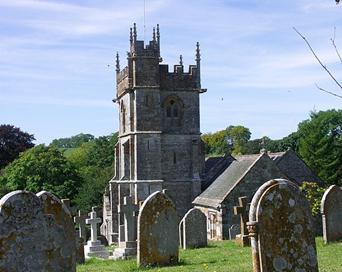 Shortly after this the family moved 5½ miles north east of Dorchester to the small village of Piddlehinton
where Lieutenant Colonel Charles Astell(6) of the 15th Regiment of Foot arrived
in 1862 to live with his family at West Lodge. He had been the Staff Officer of pensions and was
instrumental in campaigning for Ann to receive a pension in her own right in recognition
for her dedicated service to the soldiers who fought at the Battle
of Waterloo.
Shortly after this the family moved 5½ miles north east of Dorchester to the small village of Piddlehinton
where Lieutenant Colonel Charles Astell(6) of the 15th Regiment of Foot arrived
in 1862 to live with his family at West Lodge. He had been the Staff Officer of pensions and was
instrumental in campaigning for Ann to receive a pension in her own right in recognition
for her dedicated service to the soldiers who fought at the Battle
of Waterloo.
The 1871 Census shows James & Ann still in Piddlehinton together with their son Joseph. Their granddaughter Caroline Collins, now 17 years old, has been taken on by Charles Astell as a house maid. She is one of four servants at West Lodge and Charles Astell is now described as a Major General in the Army and JP for the County of Dorset. When Ann died on
28th November 1873 Colonel Astell and other officers
wanted to pay tribute to her memory so they paid for and had erected
the impressive gravestone shown at the start of this biography, which
now stands in St Mary’s churchyard at Piddlehinton. According to the Piddlehinton burial register Ann was actually buried there on 2nd December 1873.
<<< St Mary's Church, Piddlehinton
Caroline Collins then met a local agricultural labourer Frederick Sheppard whom she married as soon as she reached the age of 21 at the parish church in Piddlehinton on 23rd May 1874. Strangely no father is given on the marriage certificate and neither he nor her grandfather James are among the three witnesses to the marriage, so perhaps they did not approve of her union. In any event Joseph moved back to Fordington, living
near Mushroom Bridge. He appears to have become ill and with no family support he was taken into the Union Workhouse where he died at the age of 58 and was buried at Fordington on 6th June 1883. Frederick & Caroline raised a family of at least six children, the first three being born in Piddlehinton prior to them moving back to Sussex to live where they still were in 1901.
James Winzor survived Ann by 18 months and his demise is recorded on Ann's gravestone where it states "ALSO to the Memory of James Winzor the husband of Ann Winzor who departed this life on May 12th 1875 aged 85 years". It is followed by a short verse by an unknown author which has appeared on other soldiers gravestones from time to time.
-
I am a true Soldier
Whom all must applaud
Much hardship I suffered
At home and abroad
But the hardest engagement
I ever was in
Was the battle of Self
And the conquest of Sin
Genealogical Notes:-
(1). Ann's married name can be spelt in many different ways e.g. Winsar; Winser; Winsor; Winzar; Winzor; Winzor - I have used Winzor as shown on her gravestone
(2). Her parents Joseph Keats [Keates] and Elizabeth Brine married in Fordington at St Georges church on 21st January 1776: Her sister Sally was baptised there on 13th March 1777 and her older brother James on 25th June 1781. Her father Joseph was buried at Holy Trinity Church Dorchester on 17th April 1833 at the age of 80.
(3). His father Philip WINZOR (junior) was baptised at Fordington on 8th Feb 1763, the 4th of 5 children of his grandparents Philip WINZOR (senior) and Elizabeth LESTER who had married in the parish on 31st March 1757. Philip (senior) and Elizabeth had named their 1st child, baptised on 28th April 1758, Philip as well but he had died the following month being buried there on 16th May so he was the second child of theirs to carry that name. His fathers other siblings were Mary Lester Winzor bap 1st Jan 1760; Thomas Bap 1st Jan 1761; and a younger brother George baptised 12th Jan 1769. His grandfather Philip (senior) died that year being buried on 19th February so there were no more children from the marriage. His father Philip (junior) gave his home parish as Fordington at marriage to Mary Purchase in Holy Trinity Church on 28th June 1784. His father was buried at Holy Trinity Church on 7th Oct 1834
(4). I am grateful to the following website for background to the 12th Light Dragoons during the Battle of Waterloo - http://www.12thlightdragoons.org.uk/Public_information_XII-12L_history.htm
(5). It would be necessary to order the birth certificate to ascertain the mothers full name GRO 3rd quarter 1853 at Hastings Sussexbirth of Caroline Collins Ref 2b/30
(6). The 1871 Census for Piddletrenthide shows Charles E Astell to be a Major in the Army and JP for the County of Dorset to be living at West Lodge with his wife Harriett and 5 children. He is still there in 1881 described as a Major General retired and Jp - Caroline has left his employment. Genealogies exist which show that he was Charles Edward Astell, born 15th June 1818, a Major-General, resident at West Lodge, Piddlehinton, Dorsetshire, JP, Late Lieutenant-Colonel in 15th Regiment of Foot. Married Harriette Dare, daughter of Francis Spaight of Derry Castle, County Tipperary on 17th August 1848. He died 26th February 1901 .
(7). I have outlined James parentage in note (3) above which shows that his father had a brother George Winzor bap 12th Jan 1769. As far as I can see Marjory is a direct descendant from George vitz:-
-
George Winzor from Fordington married Jane Phippard at All Saints church Dorchester on 13th Sep 1790. Via their 3rd child James Winzor bap at Fordington on 16 Aug 1795 a labourer
James Winzor from All Saints Dorchester married Sarah Armstrong in her home parish of Charminsietr on 5th June 1820. Via their son James Winzor bap at Fordington on 29 Jan 1837 a painter
James Winzor from Fordington married Mary Stevens Palmer a native of Lytton Cheney at All Saints Dorchester 1st July 1861. Via their son James Winzor bap St Peters church Dorchester 11th Apr 1869 a house decorator
James Winzor of St Peters married Charlotte Sarah Chaffey 12th May 1889 at Woodsford Dorset. Via their son James Edward Percival Winzor bap West Fordington 4th Dec 1901
James Edward Percival Winzor married Gertrude Lovelace 2nd qtr 1930 Dorchester district. To Marjory Ge Winzor born 2nd qtr 1933 Dorchester 5a/435